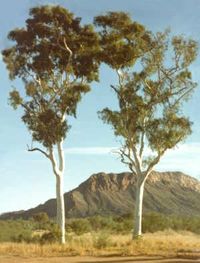Ranger uranium mine linked to Aboriginal cancer cases
Uranium mine blamed for high Aboriginal cancer rate
Accused … the Ranger uranium mine in Kakadu National Park.
Liz Minchin and Lindsay Murdoch
November 23, 2006
CANCER cases among Aboriginal people living near Australia's biggest uranium mine appear to be almost double the expected rate, a study by the Federal Government's leading indigenous research body shows.
The study also found there had been no monitoring in the past 20 years on the Ranger mine's impact on local indigenous health. Yet since 1981, there have been more than 120 spillages and leaks of contaminated water at the mine, located in the world heritage-listed Kakadu National Park.
The Herald believes the Australian Institute of Aboriginal and Torres Strait Islander Studies paper will be submitted to the Government's nuclear energy taskforce, led by Dr Ziggy Switkowski, which this week released a draft report backing the expansion of uranium mining.
The study compared the number of Aboriginal people diagnosed with cancer in the Kakadu region with the cancer rate among all Aboriginal people in the Northern Territory from 1994 to 2003. It found the diagnosis rate was 90 per cent higher than expected, with 27 cases reported.
While the study's authors stressed it was only a preliminary finding, they concluded the higher cancer rate was "a cause for serious concern and further investigation is clearly warranted".
They also called for ongoing health monitoring for all indigenous communities living near current and proposed uranium mines, at a cost of $450,000 a year.
Energy Resources of Australia, which operates Ranger, yesterday denied that people living in Jabiru and other communities near the mine were being exposed to abnormal levels of radiation.
Last month ERA, which is majority-owned by mining giant Rio Tinto, announced it would extend the life of Ranger by six years to 2020, so it could extract an additional 11,000 tonnes of uranium from low-grade ore stockpiles.
In 2003, a Senate committee found that regulation of the Ranger mine was "flawed, confusing and inadequate".
Three years on, the Howard Government has still not responded to the committee's recommendations.
Last night the traditional owners of the land backed the need for independent monitoring of the mining's health effects.
A spokesman for the Mirarr people said that while the federal Office of the Supervising Scientist monitors the mine's environmental impacts, "scant attention has been paid to the health effects of this development".
A spokeswoman for the federal Health Minister, Tony Abbott, said the study's findings on cancer rates were "questionable".
The Northern Territory health department's chief executive, Robert Griew, also said the report did not prove any link. "The excess cancers found are not typical of cancers caused by radiation but rather cover the range of cancers that reflect lifestyle issues such as smoking, diet and infection.
To read the original article from the Sydney Morning Herald, click on:
SMH
Accused … the Ranger uranium mine in Kakadu National Park.
Liz Minchin and Lindsay Murdoch
November 23, 2006
CANCER cases among Aboriginal people living near Australia's biggest uranium mine appear to be almost double the expected rate, a study by the Federal Government's leading indigenous research body shows.
The study also found there had been no monitoring in the past 20 years on the Ranger mine's impact on local indigenous health. Yet since 1981, there have been more than 120 spillages and leaks of contaminated water at the mine, located in the world heritage-listed Kakadu National Park.
The Herald believes the Australian Institute of Aboriginal and Torres Strait Islander Studies paper will be submitted to the Government's nuclear energy taskforce, led by Dr Ziggy Switkowski, which this week released a draft report backing the expansion of uranium mining.
The study compared the number of Aboriginal people diagnosed with cancer in the Kakadu region with the cancer rate among all Aboriginal people in the Northern Territory from 1994 to 2003. It found the diagnosis rate was 90 per cent higher than expected, with 27 cases reported.
While the study's authors stressed it was only a preliminary finding, they concluded the higher cancer rate was "a cause for serious concern and further investigation is clearly warranted".
They also called for ongoing health monitoring for all indigenous communities living near current and proposed uranium mines, at a cost of $450,000 a year.
Energy Resources of Australia, which operates Ranger, yesterday denied that people living in Jabiru and other communities near the mine were being exposed to abnormal levels of radiation.
Last month ERA, which is majority-owned by mining giant Rio Tinto, announced it would extend the life of Ranger by six years to 2020, so it could extract an additional 11,000 tonnes of uranium from low-grade ore stockpiles.
In 2003, a Senate committee found that regulation of the Ranger mine was "flawed, confusing and inadequate".
Three years on, the Howard Government has still not responded to the committee's recommendations.
Last night the traditional owners of the land backed the need for independent monitoring of the mining's health effects.
A spokesman for the Mirarr people said that while the federal Office of the Supervising Scientist monitors the mine's environmental impacts, "scant attention has been paid to the health effects of this development".
A spokeswoman for the federal Health Minister, Tony Abbott, said the study's findings on cancer rates were "questionable".
The Northern Territory health department's chief executive, Robert Griew, also said the report did not prove any link. "The excess cancers found are not typical of cancers caused by radiation but rather cover the range of cancers that reflect lifestyle issues such as smoking, diet and infection.
To read the original article from the Sydney Morning Herald, click on:
SMH


<< Home